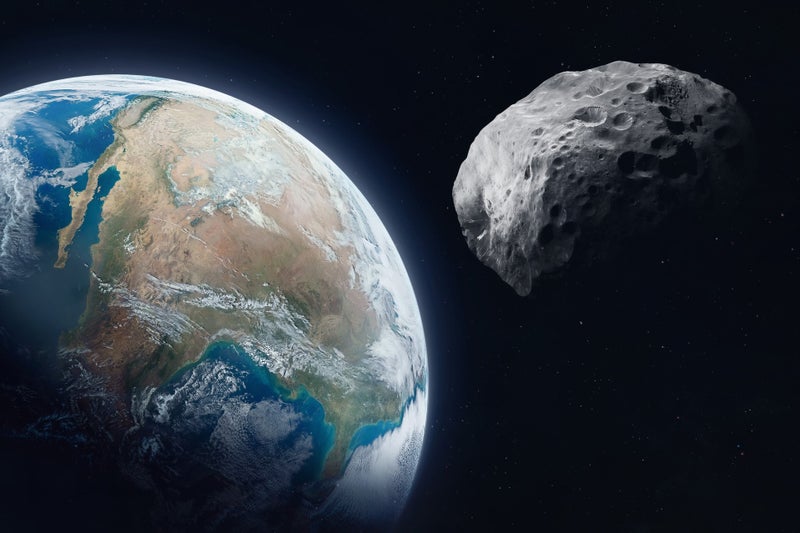A psychic who claims he successfully predicted dozens of global events in 2024 claimed we will observe 'a worldwide transformation' by the year 2032 - after NASA revised its risk of an asteroid hitting Earth. Athos Salomé, 38, from Brazil, is often referred to as the 'Living Nostradamus' after he correctly predicted past disasters including the coronavirus pandemic, Queen Elizabeth's death and the Microsoft global outage.
![[The space agency revealed Tuesday the risk now sit at 3.1 percent , a five percent increase from the previous prediction, or 1 in 32 odds of impact on December 22, 2032 (stock image)]](https://i.dailymail.co.uk/1s/2025/02/19/15/95371779-14413659-image-a-22_1739979342710.jpg)
Now, Salomé has weighed in on the worrying news that chances of the 'city-killing' asteroid 2024 YR4 smashing into Earth have increased. The space agency revealed Tuesday the risk now sit at 3.1 percent, a five percent increase from the previous prediction, or 1 in 32 odds of impact on December 22, 2032.
![[Salomé claimed to have predicted the asteroids in 2023, before it was announced by the NASA Space Station]](https://i.dailymail.co.uk/1s/2025/02/19/15/95371759-14413659-Salom_claimed_to_have_predicted_the_asteroids_in_2023_before_it_-a-25_1739979795450.jpg)
Speaking to FEMAIL Salomé said: 'In 2032 we may observe either a worldwide transformation or a successful human achievement that allows the 2024 YR4 event to come without destructive effects. 'Our existence within the cosmos proves to be both vulnerable and splendid despite every situation.'.
![[Astronomers have speculated that if it does enter Earth's atmosphere, the asteroid will likely explode midair with a force of approximately eight megatons of TNT - more than 500 times the power of the Hiroshima bomb]](https://i.dailymail.co.uk/1s/2025/02/19/17/95346389-14413659-Astronomers_have_speculated_that_if_it_does_enter_Earth_s_atmosp-a-1_1739984500052.jpg)
The psychic predicted that asteroid would either 'lose its strength' or it will be 'deflected' or even 'eliminated' before it reaches earth. He claimed by 2026 we will truly know just how serious it is, however he admitted we are in a 'time period of uncertainty.'.
Athos Salomé, 38, from Brazil, who successfully predicted dozens of global events in 2024, claimed we will observe 'a worldwide transformation' by the year 2032. He said: 'The future exists as an untainted canvas on which we still do not know what role we will play afterward.'.
Salomé claimed to have predicted the asteroids in 2023, before it was announced by the NASA Space Station. He added: 'When I first started talking about asteroids, it was in the year 2023, which on the contrary is equal to 2032. 'I said that by November 2024 it would be announced and coincidentally we had several asteroids colliding with the earth between the months of July and December and on 27 December 2024 YR4 was officially announced.'.
Salomé also suggested that NASA regularly tracks these asteroids that originate from 'larger celestial bodies' to obtain their 'mineral and metallic compositions' that have important 'scientific' and 'economic potential.'. Astronomers have speculated that if it does enter Earth's atmosphere, the asteroid will likely explode midair with a force of approximately eight megatons of TNT - more than 500 times the power of the Hiroshima bomb.
Unlike the six-mile-wide asteroid that wiped out the dinosaurs 66 million years ago, 2024 YR4 is classified as a 'city killer. That means it is not a global catastrophe, but still capable of causing significant destruction. Richard Moissl, head of the European Space Agency's planetary defense office, said this is a 'very, very rare event.'.
'This is not a crisis at this point in time. This is not the dinosaur killer. This is not the planet killer. This is at most dangerous for a city,' he added. The space agency revealed Tuesday the risk now sit at 3.1 percent , a five percent increase from the previous prediction, or 1 in 32 odds of impact on December 22, 2032 (stock image).
Salomé claimed to have predicted the asteroids in 2023, before it was announced by the NASA Space Station. NASA's announcement makes the asteroid the most threatening space rock ever recorded by modern forecasting. The last time an asteroid of greater than 98 feet in size posed such a significant risk was Apophis in 2004, when it briefly had a 2.7 percent chance of striking Earth in 2029 - a possibility later ruled out by additional observations.
2024 YR4 was first detected on December 27, 2024 by the El Sauce Observatory in Chile. Astronomers predicted a 1.2 percent chance of impact at the time, but that was enough to place the asteroid immediately at the top of NASA's automated Sentry risk list, which ranks known Near Earth Objects (NEOs) on how likely they are to collide with our planet.
Retired Canadian astronaut Chris Hadfield said that if it slams into Earth's surface in one piece rather than breaking up after entering Earth's atmosphere. The blast would send fragments of rock shooting outward at more than 10 miles per second, which is faster than the speed of the International Space Station hurtling around the Earth, Hadfield said.
The force of the blast was equivalent to detonating 50 million tons of TNT. It flattened an estimated 80 million trees over 830 square miles of forest and reportedly killed three people. The potential impact corridor of 2024 YR4 spans the eastern Pacific, northern South America, the Atlantic, Africa, the Arabian Peninsula, and South Asia -- though Moissl emphasized it is far too early for people to consider drastic decisions like relocation.
Astronomers have speculated that if it does enter Earth's atmosphere, the asteroid will likely explode midair with a force of approximately eight megatons of TNT - more than 500 times the power of the Hiroshima bomb. Alternatively, 2024 YR4 may enter Earth's atmosphere but explode in mid air in what's known as an 'air burst,' like the Tunguska asteroid did in 1908.































